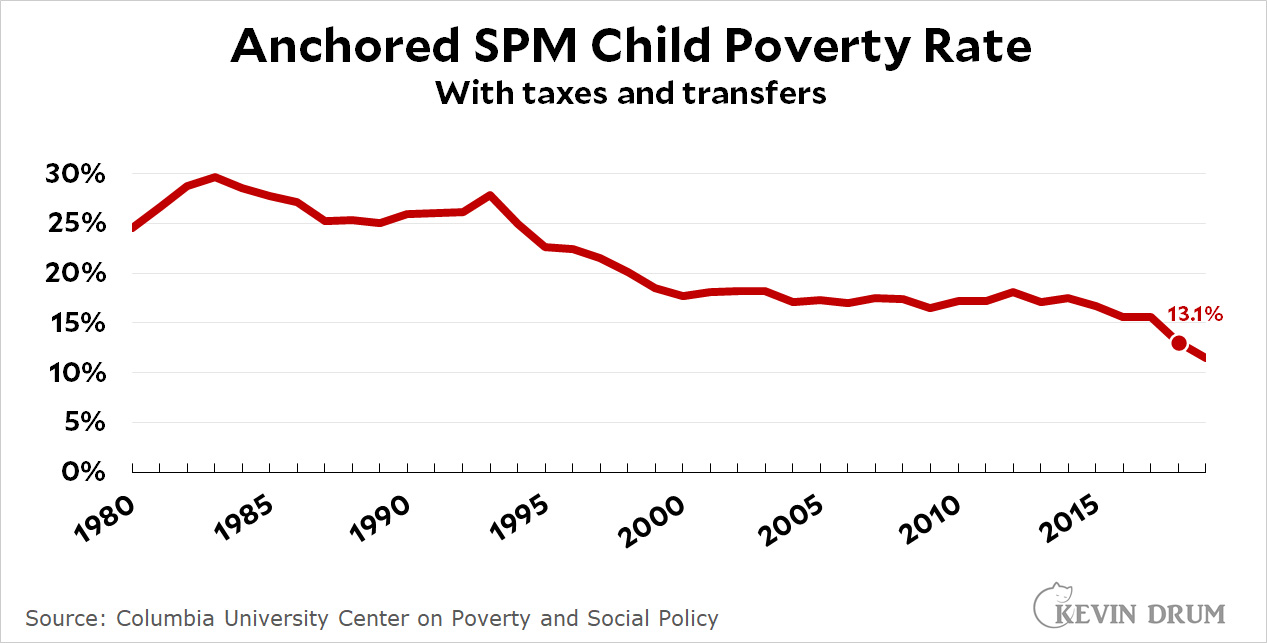What's the rate of child poverty in the United States? It's a trickier question than you might imagine. Here's the answer from the Census Bureau. This is the one you'll probably see in newspaper headlines:
 Here is the Census Bureau's "Supplemental Poverty Measure." It's the one you use if you're smart enough to know that the official figure isn't really worth a damn:
Here is the Census Bureau's "Supplemental Poverty Measure." It's the one you use if you're smart enough to know that the official figure isn't really worth a damn:
 Here's the estimate from the Center on Poverty and Social Policy at Columbia University. It's pretty similar to the Census SPM figures, but it goes back further if you want a historical look at things:
Here's the estimate from the Center on Poverty and Social Policy at Columbia University. It's pretty similar to the Census SPM figures, but it goes back further if you want a historical look at things:
 Here is the OECD's estimate, which uses a poverty rate equal to half a country's median household income. It's the figure you'll see on charts comparing the US to other countries:
Here is the OECD's estimate, which uses a poverty rate equal to half a country's median household income. It's the figure you'll see on charts comparing the US to other countries:
 Finally, here's a measure of child poverty based on consumption, not income. It's the one to use if you're a conservative:
Finally, here's a measure of child poverty based on consumption, not income. It's the one to use if you're a conservative:
 I've highlighted the 2018 estimate on all five charts since it's the most recent year common to all of them. Here's a recap:
I've highlighted the 2018 estimate on all five charts since it's the most recent year common to all of them. Here's a recap:
- Census: 16.2%
- Census SPM: 13.7%
- Columbia SPM: 13.1%
- OECD: 21.1%
- Consumption: 3.7%
So then: what's the child poverty rate in the United States?

Why shouldn't the poverty measure be based on a fraction of average income instead of median income? What has been happening in the US for the last 50 years is that the very top incomes have been getting more and more and both the median and lower fractions have been getting less. A measure based on a fraction of average income would probably show increasing poverty, at least before redistribution. This would show how the national increase in wealth is failing to trickle down - which is a fact.
The usual argument: the distribution of incomes has a lower bound (0) but no upper bound, and is extremely skewed; the median better represents the ‘center of mass’ or ‘ typical’ value. I would also argue that income inequality and poverty are different issues, as is wealth inequality, and confounding them does not help to identify and test solutions (yes, I am a progressive who believes that these are problems that government should work to ameliorate). I myself would prefer a definition of poverty as insecurity concerning any of food, shelter, adequate clothing, physical and mental health, or basic services of transportation and communication. The minimum wage should be a living wage, sufficient to provide secure access to the above.
Insecurity and inadequacy are relative. Conditions for somebody living in the poorest countries in Africa or even in Central America with an income above half the median in that country would be considered sub-poverty in the US. This is why people in those countries want to immigrate to the US to live in what we call poverty. The OECD definition based on median income is thus a measure of inequality (in the lower half) rather than objective measures of living conditions. That's the one I suggest an alternative for.
A measure based on a fraction of average income would probably show increasing poverty, at least before redistribution.
It would show greater income stratification. I doubt it would show more poverty, though. Middle class Americans have fallen ever further behind the wealthy in recent decades (true!). But that doesn't render them poverty-stricken. A person who is at 49% of the average income in Greenwich or Atherton might well be very far indeed from living in poverty. IOW, using average instead of median almost certainly would downplay the incidence of poverty in America.
Median is a better benchmark.
Pick the worse credible one and craft your policy on that.
These are children in need after all, doesn't matter who's right, just that we're not wrong or short in our assistance efforts.
Whatever the rate is currently, it's going to go up immediately after the expiration of the Child Tax Credit, thanks to Joe Manchin.
Can't argue with that, other than to point out, there was no law of physics requiring Democrats to initially bring out the program as a one year demonstration program. But, being idiots, that's naturally what Democrats did.
I think they figured that it would be so popular -- who doesn't like a couple hundred extra bucks in their pocket each month? -- that voting to extend it would be a no-brainer. Well, that didn't work out too well. Turns out a lot of upper-income people think it's a waste of money and the poorer people who really *do* need it don't vote or influence lawmakers in any meaningful way.
Too high.